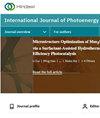Machine Learning Strategy to Achieve Maximum Energy Harvesting and Monitoring Method for Solar Photovoltaic Panel Applications
IF 2.1
4区 工程技术
Q3 CHEMISTRY, PHYSICAL
引用次数: 3
Abstract
The choice of the optimal orientation of the solar panels is by far one of the most important issues in the practical application of solar installations. The use of phase changing materials (PCMs) is an efficient approach of storing solar thermal energy. Because PCMs are isothermal in nature, they provide better density energy storage and the capacity to function across a wide temperature range. Unfortunately, this feature is very rare on various solar power panels; however, ignoring it can reduce the performance of the panels to unacceptable levels. The fact is that the angle of incidence of rays on the surface greatly affects the reflection coefficient and, consequently, the role of unacceptable solar energy. In this paper, a smart energy harvesting model was proposed. In the case of glass, when the angle of incidence varies vertically from its surface to 30, the reflection coefficient is practically unchanged and slightly less than 5%, i.e., more than 95% of the radiation goes inwards. Furthermore, the reflection increase is noticeable, and the area of the reflected radiation by 60 doubles to almost 10%. At an angle of incidence of 70, it reflects 20% of the radiation, and at 80, 40%. For most other objects, the dependence of the reflection magnitude on the angle of incidence is approximately the same.实现太阳能光伏板应用最大能量采集的机器学习策略和监测方法
在太阳能装置的实际应用中,选择太阳能板的最佳朝向是迄今为止最重要的问题之一。相变材料(PCMs)的使用是一种有效的太阳能存储方法。由于pcm本质上是等温的,它们提供了更好的密度能量存储和在宽温度范围内工作的能力。不幸的是,这种特性在各种太阳能电池板上非常罕见;然而,忽略它可能会降低面板的性能到不可接受的水平。事实是,光线在表面上的入射角极大地影响了反射系数,从而影响了不可接受的太阳能的作用。本文提出了一种智能能量收集模型。在玻璃的情况下,当入射角从其表面垂直变化到30时,反射系数几乎不变,略小于5%,即95%以上的辐射向内射入。此外,反射增加明显,反射辐射面积增加了60倍,接近10%。当入射角为70时,反射20%的辐射,当入射角为80时,反射40%的辐射。对于大多数其他物体,反射幅度对入射角的依赖关系大致相同。
本文章由计算机程序翻译,如有差异,请以英文原文为准。
求助全文
约1分钟内获得全文
求助全文
来源期刊
CiteScore
6.00
自引率
3.10%
发文量
128
审稿时长
3.6 months
期刊介绍:
International Journal of Photoenergy is a peer-reviewed, open access journal that publishes original research articles as well as review articles in all areas of photoenergy. The journal consolidates research activities in photochemistry and solar energy utilization into a single and unique forum for discussing and sharing knowledge.
The journal covers the following topics and applications:
- Photocatalysis
- Photostability and Toxicity of Drugs and UV-Photoprotection
- Solar Energy
- Artificial Light Harvesting Systems
- Photomedicine
- Photo Nanosystems
- Nano Tools for Solar Energy and Photochemistry
- Solar Chemistry
- Photochromism
- Organic Light-Emitting Diodes
- PV Systems
- Nano Structured Solar Cells

 求助内容:
求助内容: 应助结果提醒方式:
应助结果提醒方式:


